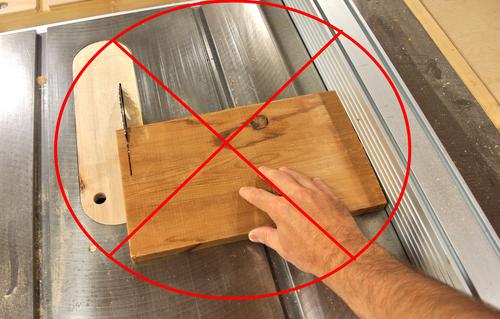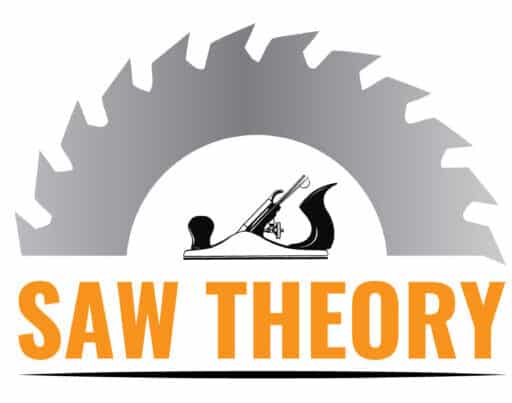To avoid kickback on a table saw, make sure to adjust the blade guard and splitters as recommended by the manufacturer. Always use a push stick when sawing small pieces of wood to keep your hands far away from the blade. Be sure that all boards are firmly clamped down before cutting.
Make sure that there is no twist or warp in the board before beginning to cut it. Avoid trying to cut too much material at once, instead breaking up large cuts into smaller ones with multiple passes through the saw if necessary. Also, never attempt a freehand cut on any piece of material larger than 12” wide without using an appropriate fence guide or miter gauge attachment for safety reasons.
Finally, be sure to wear eye protection while operating your table saw and always unplug it after use.
- Keep the Table Saw Blade Sharp: Make sure that you regularly sharpen or replace your table saw blade to ensure it is cutting optimally and minimize kickback
- Set Properly Angled Fence: Setting the fence at a 15-degree angle will help reduce kickback when making cross cuts, as well as maximizing control of the wood being cut
- Use Push Sticks for Shorter Cuts: Always use push sticks when working with shorter pieces of wood; never attempt to freehand short cuts
- Push sticks enable you to maintain better control over the piece while keeping your hands away from the blade’s path, which reduces risk of injury in the event of a kickback incident
- 4
- Apply Steady Pressure When Feeding Wood Through The Blade: Applying steady pressure when feeding stock through your table saw will keep material moving smoothly without stalling and potentially causing a kickback situation
- Install Splitter or Riving Knife on Your Table Saw : Installing either a splitter or riving knife can help prevent sudden upward movement if there is any binding between blade and stock material due to an angled cut, preventing potential injuries from occurring during operation

Credit: woodgears.ca
What Causes Kick Back on Table Saw?
Kick back on a table saw is caused by the material being cut coming in contact with the back of the blade. This can happen if the workpiece is not held firmly against the rip fence, or if it gets caught between the blade and fence as it’s pushed through. It can also occur when a board has knots or other imperfections that cause it to bind against the blade as it passes through, causing sudden force and jerking motion that kicks back at you.
To avoid kickbacks on your table saw, always make sure your work-pieces are properly secured to your rip fence before cutting them, and be mindful of any defects in your material that could potentially cause binding while passing through.
Does Saw Stop Prevent Kickback?
Yes, SawStop does prevent kickback. Kickback is the sudden force that can cause a saw to jerk back violently when the blade binds, usually due to hitting a knot or other obstruction in the material being cut. The SawStop system utilizes an electrical current that senses when contact has been made with skin and instantly stops the blade from running within milliseconds, reducing injuries caused by kickback significantly.
Furthermore, its patented braking technology will stop and retract the blade before it even begins to bind in order for kickback not to occur at all.
Does a Riving Knife Prevent Kickback?
Yes, a riving knife does help prevent kickback. A riving knife is a thin piece of metal or plastic that fits between the blade and back fence of your saw. It’s designed to keep the wood from binding on the blade and flexing as it passes through, which can cause dangerous kickback.
The riving knife helps guide the wood safely through, keeping it straight and less likely to bind or deflect off the blade. Additionally, having a true zero clearance insert with a splitter above it provides an extra level of safety by preventing any gap from forming around your cut line and allowing material to pinch against your blade—the primary cause of most kickbacks.
What is an Anti-Kickback Saw Blade?
An anti-kickback saw blade is a tool designed to prevent kickbacks when cutting wood with a circular saw. It is made up of two parts: the teeth and the gullets. The teeth are designed in such way that they push material away from the blade, rather than allowing it to be grabbed by the rotating teeth.
This reduces stress on both the user and the saw itself, making for safer and more precise cuts. Additionally, many anti-kickback blades feature special coating or heat treatment which further increases their strength and durability, ensuring your projects stay safe for years to come.
12 WORST TABLE SAW MISTAKES!! And How To Avoid Them…(DON'T DO THESE THINGS! Kickback/Binding)
Table Saw Kickback Death
Table saw kickback deaths are a tragic and often avoidable occurrence. Kickback is the sudden and unexpected force applied to the back of the saw blade, which can occur when a piece of wood binds against or pinches the blade. If not properly guarded, kickback can cause severe injuries – including death – by throwing off pieces of wood at high velocity.
The best way to prevent such accidents is to use appropriate safety guards on table saws, as well as wearing protective clothing while using them.
Table Saw Kickback Injury
Table saw kickback injury is a serious and potentially deadly hazard. It occurs when the workpiece being cut is suddenly forced back towards the operator, often resulting in cuts, lacerations, or even amputations of fingers or other body parts. In order to prevent this type of injury, it’s important to use proper technique when using a table saw—including keeping your hands away from the blade at all times and using a guard whenever possible.
Additionally, make sure that you read and understand any safety instructions provided with your table saw before operating it.
Table Saw Riving Knife
A table saw riving knife is a tool used to help prevent kick-back when using a table saw. It works by extending the blade guard and helping to keep the wood against the fence while cutting, reducing the chance of it stalling or binding. The riving knife also helps reduce tear out and splintering as well as providing additional safety for operators by keeping their hands away from the blade during operation.
How to Prevent Kickback Chainsaw
Kickback is a dangerous phenomenon that can occur while using a chainsaw. To help avoid kickback and keep you safe, it’s important to take the necessary safety precautions before operating your chainsaw. Always make sure the chain is properly tensioned and sharpened, use protective gear such as chaps, gloves and eye protection, keep both hands on the saw at all times when in operation, maintain proper distance from other objects or people when working with a chainsaw and be aware of your surroundings.
Additionally, select an appropriate length guide bar for the type of cutting job you are doing; longer bars increase risk for kickback due to their increased leverage. Taking these steps will help ensure your safety while using a chainsaw!
Conclusion
Overall, kickback on a table saw can be hazardous and cause injuries if not prevented. Following the steps outlined in this blog post is important to prevent kickback from occurring. Make sure that your blade is sharp, use a splitter or riving knife whenever possible, keep your hands and clothing away from the blade, use push sticks for small workpieces, avoid using dull blades and pay attention to what you are cutting.
By following these safety tips you can ensure that you minimize the risk of dangerous kickbacks while operating a table saw.
Table of Contents

